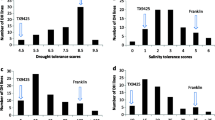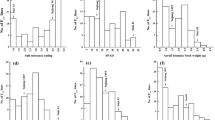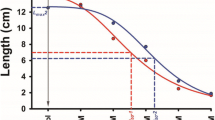Abstract
Identification of quantitative trait loci (QTL) responsible for stress tolerance could help to develop new tolerant potato cultivars through markers-assisted selection. The objective of the research was to identify and map loci that may play major role in the control of osmotic stress tolerance in potato under in vitro vegetative growth conditions. Mannitol-induced osmotic stress response of cv. White Lady and breeding line S440 as well as their 85F1 progeny for root number and root length under in vitro conditions was investigated. Interval mapping based on 200 informative markers produced a molecular marker map comprising 13 linkage groups for White Lady and 14 for S440. In total, 14 QTLs with LOD > 2 were identified from which 6 were confirmed as major QTLs. Of those six, three were associated with root length and three with root number. For root length, one major QTL was identified on chromosome XII (LOD = 4.8), which explained 52.3 % of the phenotypic variance. Two other major QTLs from an unidentified chromosome explained 64.9 and 51 % of the phenotypic variance with LODs of 5.34 and 4.8, respectively. For root number, one QTL with 19.2 % of the phenotypic variance (LOD of 2.9) was tentatively identified on chromosome IX, while another was putatively identified on chromosome XII (LOD of 2.4), together explaining 26.8 % of the phenotypic variance.
Resumen
La identificación de loci de rasgos cuantitativos (QTL) responsables de la tolerancia al agobio podría ayudar a desarrollar nuevas variedades de papa tolerantes mediante selección asistida por marcadores. El objetivo de la investigación fue identificar y crear un mapa de loci que pudiera jugar un papel importante en el control de la tolerancia al agobio osmótico en papa bajo condiciones de crecimiento vegetativo in vitro. Se investigó la respuesta del agobio osmótico inducido por manitol de la variedad White Lady y de la línea de mejoramiento S440, así como de su progenie 85 de F1, para número y longitud de raíces, bajo condiciones in vitro. Mapeando a intervalos con base en 200 marcadores informativos se produjo un mapa de marcadores moleculares compuesto por 13 grupos ligados para White Lady y 14 para S440. En total, se identificaron 14 QTL con LOD > 2, de los cuales 6 fueron confirmados como QTL’s mayores. De esos seis, se asociaron tres con longitud de raíz y tres con número de raíces. Para longitud de raíz, se identificó un QTL mayor en el cromosoma XII (LOD = 4.8), lo que explicó 52.3 % de la varianza fenotípica. Otros dos QTL mayores de un cromosoma no identificado explicaron 64.9 y 51 % de la varianza fenotípica con LODs de 5.34 y 4.8, respectivamente. Para el número de raíces, un QTL con 19.2 % de la varianza fenotípica (LOD de 2.9) se identificó tentativamente en el cromosoma IX, mientras que otro se identificó presumiblemente en el cromosoma XII (LOD de 2.4), juntos explicando 26.8 % de la varianza fenotípica.




Similar content being viewed by others
References
Bálint, A.F., F. Szira, A. Börner, and G. Galiba. 2008. Segregation- and association based mapping of loci influencing osmotic tolerance in barley. Acta Biologica Szegediensis 52(1): 101–102.
Bonierbale, M.W., R.L. Plaisted, and S.D. Tanksley. 1988. RFLP maps based on a common set of clones reveal modes of chromosomal evolution in potato and tomato. Genetics 120: 1095–1103.
Bonierbale, M.W., R.L. Plaisted, and S.D. Tanksley. 1993. A test of the maximum heterozygosity hypothesis using molecular markers in tetraploid potatoes. Theoretical and Applied Genetics 86: 481–491.
Bradshaw, J.E., C.A. Hackett, B. Pande, R. Waugh, and G.J. Bryan. 2008. QTL mapping of yield, agronomic and quality traits in tetraploid potato (Solanum tuberosum subsp. tuberosum). Theoretical and Applied Genetics 116: 193–211.
Brugmans, B., G.B. Ronald, A. Hutten, O. Nico, G.F. Rookmaker-Richard, J. Visser, and H. van Eck. 2006. Exploitation of a marker dense linkage map of potato for positional cloning of a wart disease resistance gene. Theoretical and Applied Genetics 112: 269–277.
Celebi-Toprak, F., J.A. Watanabe, and K.N. Watanabe. 2005. Molecular markers in identification of genotypic variation. In Genetic improvement of Solanaceous crops: potato, vol 1, ed. M.K. Razdan and A.K. Mattoo, 115–141. Enfield: Science Publishers.
Cernak, I., K. Decsi, S. Nagy, I. Wolf, Z. Polgar, G. Gulyas, Y. Hirata, and J. Taller. 2008. Development of a locus-specific marker and localization of the Ry sto gene based on linkage to a catalase gene on chromosome XII in the tetraploid potato genome. Breeding Science 58: 309–314.
Churchill, G.A., and R.W. Doerge. 1994. Empirical threshold values for quantitative trait mapping. Genetics 138: 963–971.
Collard, B.C.Y., and D.J. Mackill. 2009. Start Codon Targeted (SCoT) polymorphism: A simple novel DNA marker technique for generating gene- targeted markers in plants. Plant Molecular Biology 27: 86–93.
Darvasi, A., and M. Soller. 1994. Optimum spacing of markers for determining linkage between marker loci and quantitative trait loci. Theoretical and Applied Genetics 89: 351–357.
Dobranszki, J., K.M. Tabori, and A.T. Hudak. 2003. Growth and developmental responses of potato to osmotic stress under in vitro conditions. Acta Biologica Hungarica 54(3–4): 365–372.
Dong, F., S. Song, S.K. Naess, J.P. Helgeson, C. Gebhardt, and J. Jiang. 2000. Development and applications of a set of chromosome-specific cytogenetic DNA markers in potato. Theoretical and Applied Genetics 101: 1001–1007.
Ehsanpour, A.A., and R. Razavizadeh. 2005. Effect of UV-C on drought tolerance of alfalfa (Medicago sativa) callus. American Journal of Biochemistry and Biotechnology 1(2): 107–110.
Erusha, K.S., R.C. Shearman, T.P. Roirdan, and L.A. Wit. 2002. Kentucky bluegrass cultivar root and top growth responses when grown in hydroponics. Crop Science 42: 848–852.
Freyre, R., and D.S. Douches. 1994. Development of a model for marker assisted selection of specific gravity in diploid potato across environments. Crop Science 34: 1361–1368.
Freyre, R., S. Warnke, B. Sosinski, and D.S. Douches. 1994. Quantitative trait locus analysis of tuber dormancy in diploid potato (Solanum spp.). Theoretical and Applied Genetics 89: 474–480.
Gebhardt, C., E. Ritter, T. Debener, U. Schachtschabel, B. Walkemeier, and F. Salamini. 1989. RFLP analysis and linkage mapping in Solanum toberosum. Theoretical and Applied Genetics 78: 65–75.
Georgieva, M., D. Djilianov, T. Konstantinova, and D. Parvanova. 2004. Screening of Bulgarian raspberry cultivars and elites for osmotic tolerance in vitro. Biotechnology and Biotechnological Equipment 95–98.
Gopal, J., and K. Iwama. 2007. In vitro screening of potato against water-stress mediated through sorbitol and polyethylene glycol. Plant Cell Reports 26: 693–700.
Gorji, M.A., P. Poczai, Z. Polgar, and J. Taller. 2011. Efficiency of arbitrarily amplified dominant markers (SCoT, ISSR and RAPD) for diagnostic fingerprinting in tetraploid potato. American Journal of Potato Research 88(3): 226–237.
Hackett, C.A., and Z.W. Luo. 2003. TetraploidMap: Construction of a linkage map in autotetraploid species. Journal of Heredity 94: 358–359.
Hackett, C.A., J.E. Bradshaw, R.C. Meyer, J.W. McNicol, D. Milbourne, and R. Waugh. 1998. Linkage analysis in tetraploid species: A simulation study. Genetics Research 71: 143–154.
Hackett, C.A., J.E. Bradshaw, and J.W. McNicol. 2001. Interval mapping of QTLs in autotetraploid species. Genetics 159: 1819–1832.
Hackett, C.A., B. Pande, and G.J. Bryan. 2003. Constructing linkage maps in autotetraploid species using simulated annealing. Theoretical and Applied Genetics 106: 1107–1115.
Howden, R., and C.S. Cobbett. 1992. Cadmium-sensitive mutants of Arabidopsis thaliana. Plant Physiology 99: 100–107.
Hsissou, D., and J. Bouharmont. 1994. In vitro selection and characterization of drought-tolerant plants of durum wheat (Triticum durum Desf). Agronomy 2: 65–70.
Ingram, K.T., F.D. Bueno, O.S. Namuco, E.B. Yambao, and C.A. Beyrouty. 1994. Rice root traits for drought resistance and their genetic variation. In Rice roots: nutrient and water use, ed. G.J.D. Kirk, 67–77. Manila: IRRI.
Iwama, K., and J. Yamaguchi. 2006. Abiotic stresses. In Handbook of potato production, improvement and postharvest management, ed. J. Gopal and S.M. Khurana, 231–278. New York: Food Product Press.
Jacobs, J.M.E., H. van Eck, P. Arens, B. Verkerk-Bakker, B.T. Hekkert, H.J.M. Bastlaanssen, A. El-Kharbotly, A. Pereira, E. Jacobsen, and W.J. Stiekema. 1995. A genetic map of potato (Solanum tuberosum) integrating molecular markers, including transposons, and classical markers. Theoretical and Applied Genetics 91: 289–300.
Lahlou, O., and J.F. Ledent. 2005. Root mass and depth, stolons and roots formed on stolons in four cultivars of potato under water stress. European Journal of Agronomy 22: 159–173.
Leport, L., M. Petrivalsky, and M. Chappart. 1993. Effectors for the osmoinduced proline response in higher plants. Plant Physiology and Biochemistry 31: 911–922.
Lilley, J.M., M.M. Ludlow, S.R. McCouch, and J.C. O’Toole. 1996. Locating QTL for osmotic adjustment and dehydration tolerance in rice. Journal of Experimental Botany 302: 1427–1436.
Luo, Z.W., C.A. Hackett, J.E. Bradshaw, J.W. McNicol, and D.M. Milbourne. 2001. Construction of a genetic linkage map in tetraploid species using molecular markers. Genetics 157: 1369–1385.
Maas, E.V. 1985. Crop tolerance to saline sprinkling water. Plant and Soil 89: 273–284.
Maruyama, H., R. Koyama, T. Oi, M. Yagi, M. Takeda, M. Kanechi, N. Inagaki, and Y. Uno. 2008. In vitro evaluation of osmotic stress tolerance using a novel root recovery assay. Plant Cell Tissue and Organ Culture 95: 101–106.
Menendez, C.M., E. Ritter, R. Schaefer-Pregl, B. Walkemeier, A. Kalde, F. Salamini, and C. Gebhardt. 2002. Cold sweetening in diploid potato: Mapping quantitative trait loci and candidate genes. Genetics 162: 1423–1434.
Milbourne, D., R. Meyer, A. Collins, L. Ramsay, C. Gebhardt, and R. Waugh. 1998. Isolation, characterization and mapping of simple sequence repeat loci in potato. Molecular and General Genetics 259: 233–245.
Mohamed, M.A.H., P.J.C. Harris, and J. Henderson. 2000. In vitro selection and characterization of a drought clone of Tagetes minuta. Plant Science 159: 213–222.
Peuke, A.D., C. Scharml, W. Hartung, and H. Rennenberg. 2002. Identification of drought-sensitive beech ecotypes by physiological parameters. New Phytologist 154: 373–387.
Price, A.H., K.A. Steele, B.J. Moore, P.B. Barraclough, and L.J. Clark. 2000. A combined RFLP and AFLP linkage map of upland rice (Oryza sativa L.) used to identify QTLs for root-penetration ability. Theoretical and Applied Genetics 100: 49–56.
Quarrie, S.A. 1996. New molecular tools to improve the efficiency of breeding for increased drought resistance. Plant Growth Regulators 20: 167–178.
Ribaut, J.M., C. Jiang, D. Gonzáles de León, G.O. Edmeades, and D.A. Hoisington. 1997. Identification of quantitative trait loci under drought conditions in tropical maize. II. Yield components and marker-assisted selection strategies. Theoretical and Applied Genetics 94: 887–896.
Rossouw, F.T., and J. Waghmarae. 1995. The effect of drought on growth and yield of two South African potato cultivars. South African Journal of Science 91: 149–150.
Rouppe van der Voort, J., P. van Zandvoort, H. van Eck, R.T. Folkertsma, R.C.B. Hutten, J. Draaistra, F.J. Gommers, E. Jacobsen, J. Helder, and J. Bakker. 1997. Use of allele specificity of comigrating AFLP markers to align genetic maps from different potato genotypes. Molecular Genetics and Genomics 255: 438–447.
Sakthivelu, G., M.K. Akitha Devi, P. Giridhar, T. Rajasekaran, G.A. Ravishanker, T. Nedev, and G. Kosturkova. 2008. Drought-induced alterations in growth, osmotic potential and in vitro regeneration of soybean cultivars. General and Applied Plant Physiology 34(1–2): 103–112. Special issue.
Sari-Gorla, M., P. Krajewski, N. Di Fonzo, M. Villa, and C. Frova. 1999. Genetic analysis of drought tolerance in maize by molecular markers. II. Plant height and flowering. Theoretical and Applied Genetics 99: 289–295.
Schaefer-Pregl, R., E. Ritter, L. Concilio, J. Hesselbach, L. Lovatti, B. Walkemeier, H. Thelen, F. Salamini, and C. Gebhardt. 1998. Analysis of quantitative trait loci (QTLs) and quantitative trait alleles (QTAs) for potato tuber yield and starch content. Theoretical and Applied Genetics 97: 834–846.
Schafleitner, R., R.O.G. Rosales, A. Gaudin, C.A.A. Aliaga, G.N. Martinez, L.R.T. Marca, L.A. Bolivar, F.M. Delgado, R. Simon, and M. Bonierbale. 2007. Capturing candidate drought tolerance traits in two native Andean potato clones by transcription profiling of field grown plants under water stress. Plant Physiology and Biochemistry 45: 673–690.
Stam, P. 1993. Construction of integrated genetic linkage maps by means of a new computer package: Joinmap. The Plant Journal 3: 739–744.
Tanksley, S.D. 1993. Mapping polygenes. Annual Review of Genetics 27: 205–233.
Tuberosa, R., M.C. Sanguineti, P. Landi, S. Salvi, E. Casarini, and S. Conti. 1998. RFLP mapping of quantitative trait loci controlling abscisic acid concentration in leaves of drought-stressed maize (Zea mays L.). Theoretical and Applied Genetics 97: 744–755.
van den Berg, J.H., E.E. Ewing, R.L. Plaisted, S. McMurry, and M. Bonierbale. 1996a. QTL analysis of potato tuberization. Theoretical and Applied Genetics 93: 307–316.
van den Berg, J.H., E.E. Ewing, R.L. Plaisted, S. McMurry, and M. Bonierbale. 1996b. QTL analysis of potato tuber dormancy. Theoretical and Applied Genetics 93: 317–324.
Van Eck, H., J. Rouppe van der Voort, J. Draaistra, P. van Zandvoort, E. van Enckevort, B. Segers, J. Peleman, E. Jacobsen, J. Helder, and J. Bakker. 1995. The inheritance and chromosomal localization of AFLP markers in a non-inbred potato offspring. Molecular Breeding 1: 397–410.
Walbot, V., and C. Warren. 1988. Regulation of Mu element copy number in maiz line with an active or inactive mutator transposonable element system. Molecular Genetics and Genomics 211: 27–34.
Watanabe, S., K. Kojima, Y. Ide, and S. Sasaki. 2000. Effects of Saline and osmotic stress on praline and sugar accumulation in Populus euphratica in vitro. Plant Cell, Tissue and Organ Culture 63: 199–206.
Wu, S.J., L. Ding, and J.K. Zhu. 1996. SOS1, a genetic locus essential for salt tolerance and potassium acquisition. The Plant Cell 8: 617–627.
Yadav, R., B. Courtois, N. Huang, and G. McLaren. 1997. Mapping genes controlling root morphology and root distribution on a double-haploid population of rice. Theoretical and Applied Genetics 94: 619–632.
Acknowledgements
Present publication was realized with the support of the project TÁMOP-4.2.2/B-10/1-2010-0025 and NKTH-TECH-09-A3-2009-0210. The experiments comply with the current laws of Hungary in which they were performed.
Author information
Authors and Affiliations
Corresponding author
Rights and permissions
About this article
Cite this article
Gorji, A.M., Matyas, K.K., Dublecz, Z. et al. In Vitro Osmotic Stress Tolerance in Potato and Identification of Major QTLs. Am. J. Potato Res. 89, 453–464 (2012). https://doi.org/10.1007/s12230-012-9268-x
Published:
Issue Date:
DOI: https://doi.org/10.1007/s12230-012-9268-x




